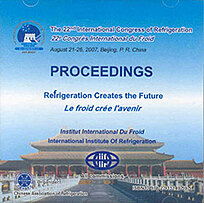
Summary
Mechanically pumped 2-phase fluid loops often have the problem of insufficient sub-cooling to operate the pumps without cavitation. This paper describes the use of 2-phase accumulators for controlling CO2 loops to obtain forced sub-cooling and accurate evaporator control. The technique of using 2-phase accumulators for loop control was first applied in satellite cooling. Two accumulator controlled loops have been successfully developed at NIKHEF. One CO2 loop for cooling the AMS particle detector which will study cosmic radiation onboard the International Space Station and a second CO2 loop is developed for cooling the LHCb-VELO particle detector which will study CP-violation at the CERN laboratory in Geneva (Switzerland). A 2-phase accumulator has the advantage of controlling the evaporator and condenser pressures independent of the primary cooler temperature. It is therefore possible to create as much sub-cooling for the pump as desired. It is even possible to operate the loop in single phase, a feature which turns out to be very convenient during start-up and cooling-down procedures. A 2-phase accumulator for evaporator pressure control in combination with an internal heat exchanger between the liquid feed and the 2-phase return line creates a very stable evaporator with a guaranteed evaporation at low vapor qualities. In this way the evaporator heat transfer can be tuned and evaporator dry-out is prevented.
Available documents
Format PDF
Pages: ICR07-B1-1565
Available
Public price
20 €
Member price*
Free
* Best rate depending on membership category (see the detailed benefits of individual and corporate memberships).
Details
- Original title: Controlling a 2-phase CO2 loop using a 2-phase accumulator.
- Record ID : 2007-2823
- Languages: English
- Source: ICR 2007. Refrigeration Creates the Future. Proceedings of the 22nd IIR International Congress of Refrigeration.
- Publication date: 2007/08/21
Links
See other articles from the proceedings (839)
See the conference proceedings
Indexing
-
Themes:
Two-phase flow;
CO2 - Keywords: Two-phase flow; Electronics; Design; Cooling; Component; CO2
-
Experimental observation of sedimentation pheno...
- Author(s) : YAMAGUCHI H., IWAMOTO Y., OZAKI S., et al.
- Date : 2014/08/02
- Languages : English
- Source: 11th IIR Gustav Lorentzen Conference on Natural Refrigerants (GL2014). Proceedings. Hangzhou, China, August 31-September 2, 2014.
- Formats : PDF
View record
-
A phase-field approach for two-fluid flow simul...
- Author(s) : STALIO E., MENCINGER J., ZUN I.
- Date : 2005/08/02
- Languages : English
- Source: Commercial Refrigeration. Thermophysical Properties and Transfer Processes of Refrigerants. Proceedings of the IIR International Conferences.
- Formats : PDF
View record
-
Non-equilibrium approach in simulations of the ...
- Author(s) : BODYS J., SMOLKA J., PALACZ M., HAIDA M., BANASIAK K.
- Date : 2020/12/07
- Languages : English
- Source: 14th IIR-Gustav Lorentzen Conference on Natural Refrigerants (GL2020). Proceedings. Kyoto, Japon, December 7-9th 2020.
- Formats : PDF
View record
-
An improved homogeneous relaxation model for CO...
- Author(s) : MA L., DENG J.
- Date : 2017/07/20
- Languages : English
- Source: 8th international conference on compressors and refrigeration, 2017.
- Formats : PDF
View record
-
A concept of performance improvements for R744 ...
- Author(s) : BODYS J., SMOLKA J., BANASIAK K., et al.
- Date : 2018/06/18
- Languages : English
- Source: 13th IIR Gustav Lorentzen Conference on Natural Refrigerants (GL2018). Proceedings. Valencia, Spain, June 18-20th 2018.
- Formats : PDF
View record
